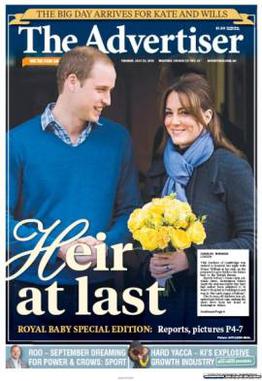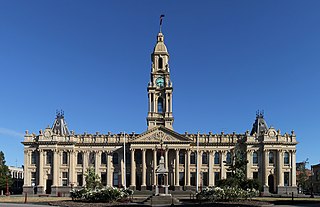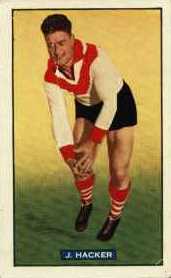
The Advertiser is a daily tabloid format newspaper based in the city of Adelaide, South Australia. First published as a broadsheet named The South Australian Advertiser on 12 July 1858, it is currently a tabloid printed from Monday to Saturday. The Advertiser came under the ownership of Keith Murdoch in the 1950s, and the full ownership of Rupert Murdoch in 1987. It is a publication of Advertiser Newspapers Pty Ltd (ADV), a subsidiary of News Corp Australia, itself a subsidiary of News Corp. Through much of the 20th century, The Advertiser was Adelaide's morning broadsheet, The News the afternoon tabloid, with The Sunday Mail covering weekend sport, and Messenger Newspapers community news. The head office was relocated from a former premises in King William Street, to a new News Corp office complex, known as Keith Murdoch House at 31 Waymouth Street.

South Melbourne is an inner suburb in Melbourne, Victoria, Australia, 3 kilometres (1.9 mi) south of Melbourne's Central Business District, located within the City of Port Phillip local government area. South Melbourne recorded a population of 11,548 at the 2021 census.

Eltham is a suburb of Melbourne, Victoria, Australia, 20 km north-east of the Central Business District, located within the Shire of Nillumbik local government area. Eltham recorded a population of 18,847 at the 2021 census.

The Argus was an Australian daily morning newspaper in Melbourne from 2 June 1846 to 19 January 1957, and was considered to be the general Australian newspaper of record for this period. Widely known as a conservative newspaper for most of its history, it adopted a left-leaning approach from 1949. The Argus's main competitor was David Syme's more liberal-minded newspaper, The Age.

A coffee palace was an often large and elaborate residential hotel that did not serve alcohol, most of which were built in Australia in the late 19th century.
There were two Australian periodicals called The Port Phillip Gazette.

The Melbourne Advertiser was the first newspaper published in Melbourne, in what was then known as Port Phillip District, and now is Victoria, Australia. It was published by John Pascoe Fawkner, a co-founder of Melbourne. The first edition appeared on 1 January 1838, handwritten in ink by Fawkner himself and displayed at his hotel.
The Riverine Herald is a tri-weekly newspaper based in Echuca in Victoria's Goulburn Valley, servicing the Echuca-Moama area. The paper is owned by McPherson Media Group.
David Hastie "Bud" Adamson was an Australian rules footballer who played for South Melbourne in the Victorian Football League (VFL).
James Moore (1826–1887) was an engineer responsible for the first steam-powered railway to operate in Australia.
The Evelyn Observer was a weekly newspaper released from 1873 to 1942 in the north-east area of Melbourne, Victoria in Australia. It was first published on 31 October 1873 from a school house at Kangaroo Ground. Andrew Ross, the district's first school master and hotel-keeper was the Observer's first proprietor, and he enlisted the help of a printer, John Rossiter, who became the first editor. It then operated out of a dedicated building on the top of a hill. After the transfer of the newspaper office to Hurstbridge, the building was purchased by the Eltham Shire Council.
The Portland Guardian was a weekly newspaper published between 1842 and 1964 in the seaport town of Portland, Victoria, Australia. It was known as the Portland Guardian and Normanby General Advertiser from 1842 to 1876.
The Traralgon Record was a weekly newspaper published in Traralgon, Victoria from 1883 to 1932.

Jack Hacker was an Australian rules footballer who played with South Melbourne in the Victorian Football League (VFL).
The Advocate was a weekly newspaper founded in Melbourne, Victoria in 1868 and published for the Catholic Archdiocese of Melbourne from 1919 to 1990. It was first housed in Lonsdale Street, then in the grounds of St Francis' Church, and from 1937 in a'Beckett Street, Melbourne.
The Telegraph was a newspaper in Adelaide, South Australia, founded in 1862, and merged with The Express to become The Express and Telegraph, published from 1867 to 1922.
James Allison was a theatre manager in Sydney, Adelaide and Melbourne. He engaged and managed local and overseas opera, drama, circus, minstrel and variety companies throughout the Australasian colonies.
The Sportsman (1881–1904?) was a weekly newspaper published in Melbourne, Australia, devoted to sporting news, predominantly racing, with football or cricket second, with columns on handball, shooting, boxing, cycling, wrestling, swimming, yachting and other masculine sports.
The Lorgnette, subtitled "Theatrical Journal and Programme", was a weekly magazine in Melbourne, Australia, devoted to theatre, opera and the concert stage. The magazine was published Saturdays and sold for 2d at the major entertainment venues where it had exclusive rights, and elsewhere.

Philip Melville Salmon was an Australian politician. He was a member of the Victorian Legislative Assembly from 1892 to 1894, representing the electorate of Port Melbourne.









